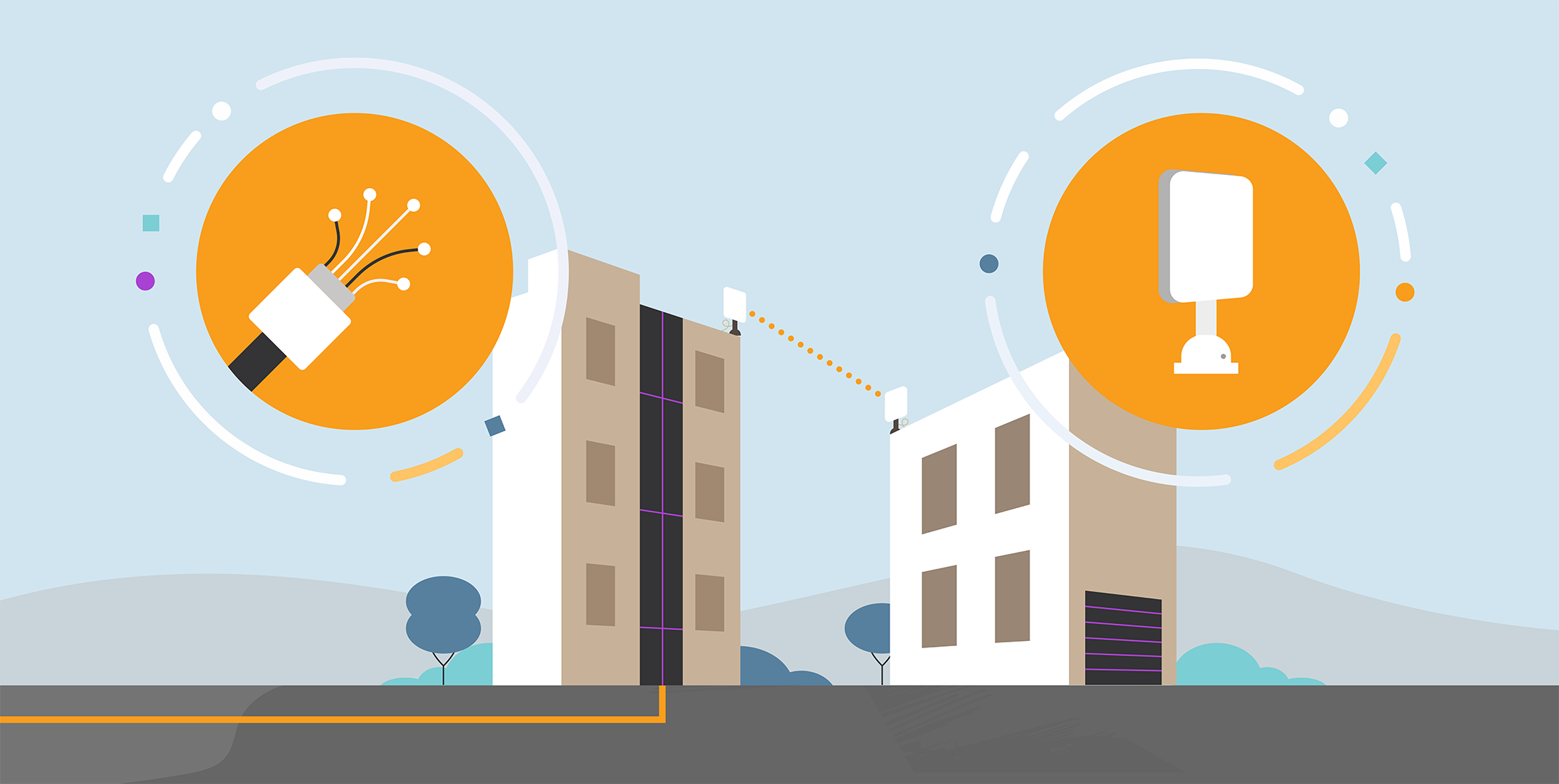Summary:
Fixed wireless vs. fiber internet is one of the most important decisions for businesses evaluating connectivity. While fiber has long been seen as the gold standard, Sail Internet’s enterprise-grade fixed wireless—built on dedicated, non-cellular infrastructure—delivers the same gigabit speeds and reliability while being faster to install, more flexible, and more cost-effective. This guide compares the two technologies so IT leaders and business decision-makers can choose the smarter option for their operations.
Key Takeaways:
- Fixed wireless delivers fiber-comparable gigabit speeds with enterprise-grade reliability.
- Fiber is strong, but Sail’s fixed wireless can match its performance and serves as an alternative, being deployed in days, not months.
- Fixed wireless provides coverage in areas where fiber hasn’t been built, extending reach without sacrificing quality.
- Fiber’s reliance on construction makes it costly and prone to delays, while fixed wireless avoids these challenges.
- A major fiber cut can take days to repair
- For enterprises, fixed wireless is often the smarter choice, offering equal performance with faster deployment and better value.
What is Fixed Wireless Access (FWA)?
Fixed Wireless Access (FWA) delivers internet connectivity through radio signals rather than buried cables. Sail’s enterprise-grade FWA uses dedicated point-to-point wireless links—not cellular networks—to deliver consistent, high-speed, low-latency internet for businesses that demand reliability. Unlike traditional wired options, FWA doesn’t require underground cables, which means installation is quick and cost-effective, and repairs take a matter of hours rather than days.
What is Fiber Internet?
Fiber internet uses fiber-optic cables to transmit data via light signals. It’s known for its high-quality internet connectivity performance due to its ultra-fast speeds and symmetrical upload and download rates. However, fiber requires extensive physical infrastructure, which is expensive and time-consuming to build. Fiber is also prone to fiber cuts due to construction or natural elements. Significant fiber cuts can take days to repair as the cable is underground and may require extensive labor.
Side-by-Side Comparison for Fixed Wireless vs Fiber
Here’s how fixed wireless vs fiber stacks up across the most important factors:
| Feature | Fixed Wireless Access (FWA) | Fiber Internet |
| Speed | 1 to multi-Gbps | 1 to multi-Gbps |
| Reliability | Point-to-point connections provide 99.99% uptime, and redundant network architecture ensures consistent performance. | Vulnerable to fiber cuts and physical infrastructure outages, despite stable operational performance. |
| Availability | Available in urban/high-density, suburban, or rural areas as well as hard-to-reach places. | Mostly in urban/high-density areas |
| Installation Time | Quick installation from days to weeks. | Weeks/Months due to construction and availability |
| Cost | Lower setup costs and competitive monthly rates | Higher monthly costs and expensive rollout |
| Technology Type | Dedicated point-to-point or Broadband point-to-multipoint wireless (non-cellular). | Fiber optic cable |
Verdict: Fixed wireless access (FWA) isn’t a fallback to fiber—it’s a modern enterprise solution that matches fiber’s gigabit speeds and reliability, surpassing it in deployment speed, scalability, and cost efficiency. FWA provides a better balance of performance and value for businesses that can not afford long delays or excessive installation costs.
Fixed Wireless Provides a Practical and Efficient Solution
- Fixed wireless internet delivers high-speed connectivity on par with or surpassing fiber in cost, deployment speeds, and reliability. It shouldn’t be seen as a backup to fiber but instead as a solid primary service that delivers enterprise-grade connectivity.
- Better Cost-to-Value Ratio: Fixed wireless provides a better balance of performance and price, offering robust and reliable service at a more predictable and affordable monthly rate.
- Faster and Simpler Deployment: Fixed wireless can be deployed in days or weeks, not months, as it does not require trenching or new cables.
- Lower Upfront Costs: It bypasses the need for costly and disruptive construction, resulting in significantly lower installation and activation fees.
- Reliability: Sail Internet strives for 99.99% uptime. In the rare case of an outage, repairs can be rectified in a matter of hours, as all equipment is above ground.
Why Choose Fixed Wireless for Your Business?
With Sail Internet’s Fixed Wireless Access (FWA), you get:
- Gigabit performance: Equal to fiber, supporting cloud platforms, video conferencing, VoIP, and SaaS applications.
- Rapid deployment: Installed in days or weeks, not months—ideal for businesses that can’t wait.
- Cost efficiency: A fraction of fiber’s construction costs, with predictable monthly pricing.
- Scalable solutions: Easily extend connectivity across campuses, industrial zones, or multi-building sites.
- Enterprise-grade reliability: Redundant network architecture ensures consistent uptime, even in fiber-rich areas.
Fixed Wireless Beats Fiber on Deployment & Cost
When a prominent San Francisco church needed reliable, high-speed internet across multiple buildings, fiber installation wasn’t practical—the construction quotes exceeded $100,000 and would have disrupted daily operations. Sail Internet deployed gigabit fixed wireless in weeks, saving the church over $100K while seamlessly powering live streaming, administration, and community programs.
This case shows that Sail’s fixed wireless doesn’t just keep up with fiber—it can outperform it in speed, cost, and flexibility.
Fixed Wireless Provides Comparable Reliability to Fiber
While fiber internet has traditionally been viewed as the most reliable connectivity option, Sail Internet’s enterprise-grade fixed wireless delivers equivalent reliability with several key advantages. Both technologies can achieve 99.99% uptime under optimal conditions, but fixed wireless offers superior resilience against common infrastructure failures. Fiber networks are vulnerable to cuts from construction activities, natural disasters, and underground utility work—incidents that can leave businesses offline for days while crews locate and repair buried cables. In contrast, fixed wireless infrastructure operates above ground with redundant pathways and backup systems, enabling technicians to identify and resolve issues quickly. When outages occur, fixed wireless repairs typically take hours rather than the days required for fiber restoration. This translates to significantly less downtime and business disruption, making fixed wireless comparable to fiber in reliability, but usually superior in real-world resilience.
Is Fixed Wireless Internet or Fiber Best for Your Business?
So, which is better: fixed wireless vs fiber? Businesses can utilize FWA as a reliable primary internet service, and no longer need to view it solely as a backup to fiber. Sail Internet provides enterprise-grade internet services with 99.99% uptime and low latency, along with a rapid installation process of less than 10 days.
Fiber installation can take months or even years, especially in commercial parks, industrial zones, or newly developed areas. It may not be possible for historical buildings and/or landmarks. The high cost of trenching and permitting can be prohibitive for IT teams that need connectivity today. Sail’s fixed wireless provides enterprises with rapid deployment, enabling critical business applications like cloud computing, SaaS platforms, VoIP, video conferencing, and remote team collaboration—without the delays of fiber construction.
- Enter your address to check for service.
- You can also speak to one of our experts for more information. Speak to them at contact@sailinternet.com.
- If you’re outside of fiber’s reach, want faster installation, or simply want a more affordable and flexible internet option, Fixed Wireless Access (FWA) could be the smarter decision.
Our Sail Internet team makes connectivity simple, fast, and accessible for your business.

Reviewed by Katie Krzywicki (31 August 2025): Katie Krzywicki is part of the commercial team here at Sail. Before coming to Sail, she accumulated nearly a decade of telecom experience across Pacnet, Telstra, and Amazon/eero.
LinkedIn

